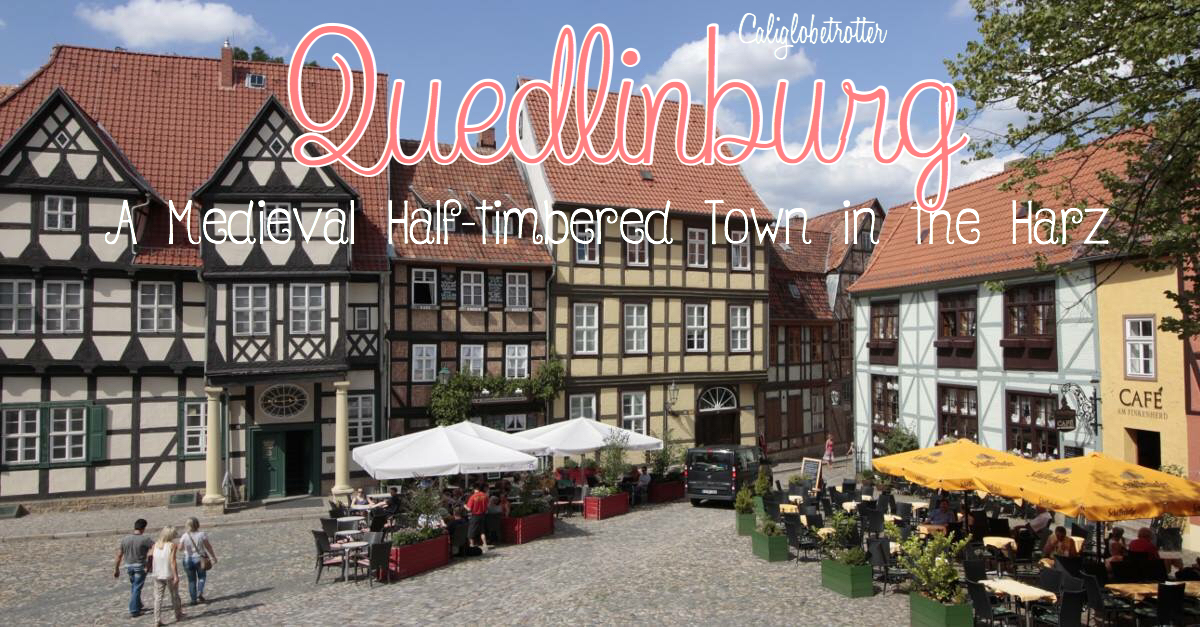
Disclaimer: This post contains affiliate links. If you click on one and make a purchase, I might make a little extra spending money, at no extra cost to you. As always, all opinions are my own and these products/services have been found useful during our travels and come highly recommended to you from yours truly!
What could possibly be more idyllic than strolling through a medieval town with over 1,400 half-timbered houses down rows and rows of cobbled-stoned streets that haven’t changed much for hundreds of years on a sunny afternoon? Not much in my book! Quedlinburg is one of the most STUPID PRETTY towns in Europe and it doesn’t get much better than this!!
Straddling the Bode River in the foothills of the Harz region in Saxony-Anhalt, Quedlinburg is one of the most romantic medieval towns in Germany and is more like a Disney pop-up storybook filled with history, architecture and treasure which entitled the town to become a UNESCO World Heritage site in 1994. Plus, with the surrounding Harz National Park steeped in legends and myths of witches and warlocks, what’s not to love about visiting!? I promise you, it’ll be the perfect weekend trip to the Harz Mountains!
Want to Visit? PIN IT FOR LATER!!
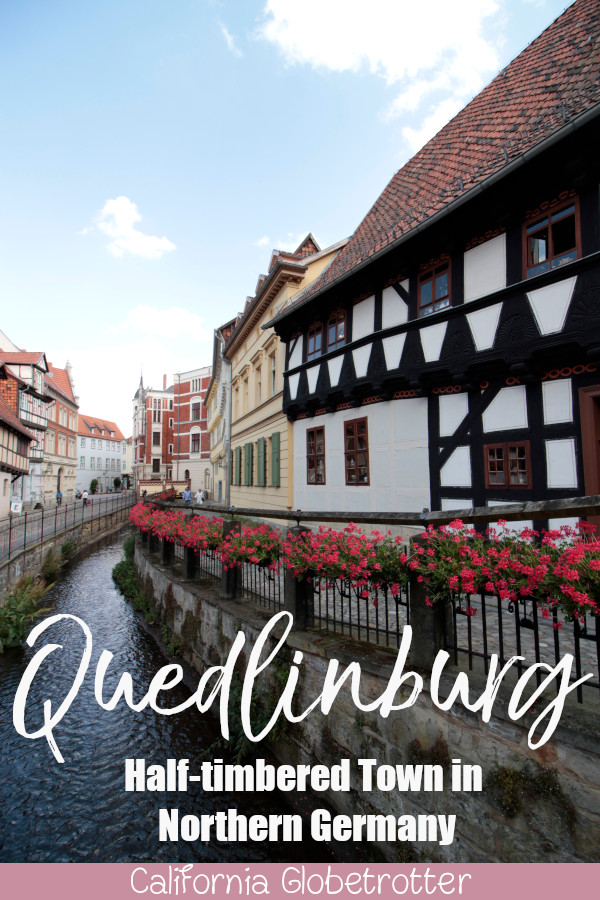
This article is now available as a mobile app. Go to GPSMyCity to download the app for GPS-assisted travel directions to the attractions featured in this article!
How to AVOID Looking Like a Tourist in Europe
History of the Town
The town has a colorful history dating as far back as the 10th century when it was ruled by King Heinrich I, who is accredited with being the founder of medieval Germany, therefore, making Quedlinburg the first capital of Germany. The town became prosperous because of the nearby silver, copper and tin mines. Mathilde, King Heinrich I’s widow, founded a convent here for aristocratic women in 936 and her granddaughter would become the Abbess in 966. For the next 800 years, the town would be ruled by women (Go Women!), that is until Napoleon decided to invade in the early 19th century and disbanded the Abbey. So, it should come as no surprise when I mention that the first female doctor came from Quedlinburg.
What I found the most interesting was that under Nazi Germany, the town became the epicenter for Nazi propaganda. Heinrich Himmler turned the Stiftkirche St. Servatius on the Schlossberg (“castle mountain”) into a shrine to the SS because he was inspired by the church’s connection to Germany’s first king, Heinrich I, therefore, turning his memory into a cult. The “Holy Roman Empire of the German Nation” lasted nearly 1000 years which was a dream of the Nazi Party. Heinrich Himmler saw himself as the reincarnation of the “most German of all German” rulers. Somehow, the town thankfully suffered minimal damage during World War II. As the town is located in the former East Germany, known at the DDR and controlled was by the Communists, the town became a little shabby and run down. But today it is one of Europe’s best preserved medieval towns.
What to Do in the Town
As always, start your sightseeing in Quedlinburg in the heart of the town, the Markt, which is a combination of a mixture of buildings and various architectural styles, ranging from 16th century gilded houses to a Renaissance Rathaus (City Hall). Here, you’ll find many cafes and restaurants, as well as the information center. You can also hop aboard the adorable mini-train trolley and take a tour of the town, or you can do a walking tour, only in German. Quedlinburg is one of the cutest half-timbered towns in Germany and is easy day trip from Berlin or Hanover!


Jutting out in different directions from the Markt are many small lanes, best explored one by one. But begin you exploration by searching for the Gildehaus zur Rose (Breite Strasse 39), just caddycorner from the Rathaus, which is renowned for its textbook Renaissance carvings. Winding, cobbled-stoned streets and alleys make Quedlinburg one of the most romantic towns in Germany to meander through, hand in hand with someone you love!
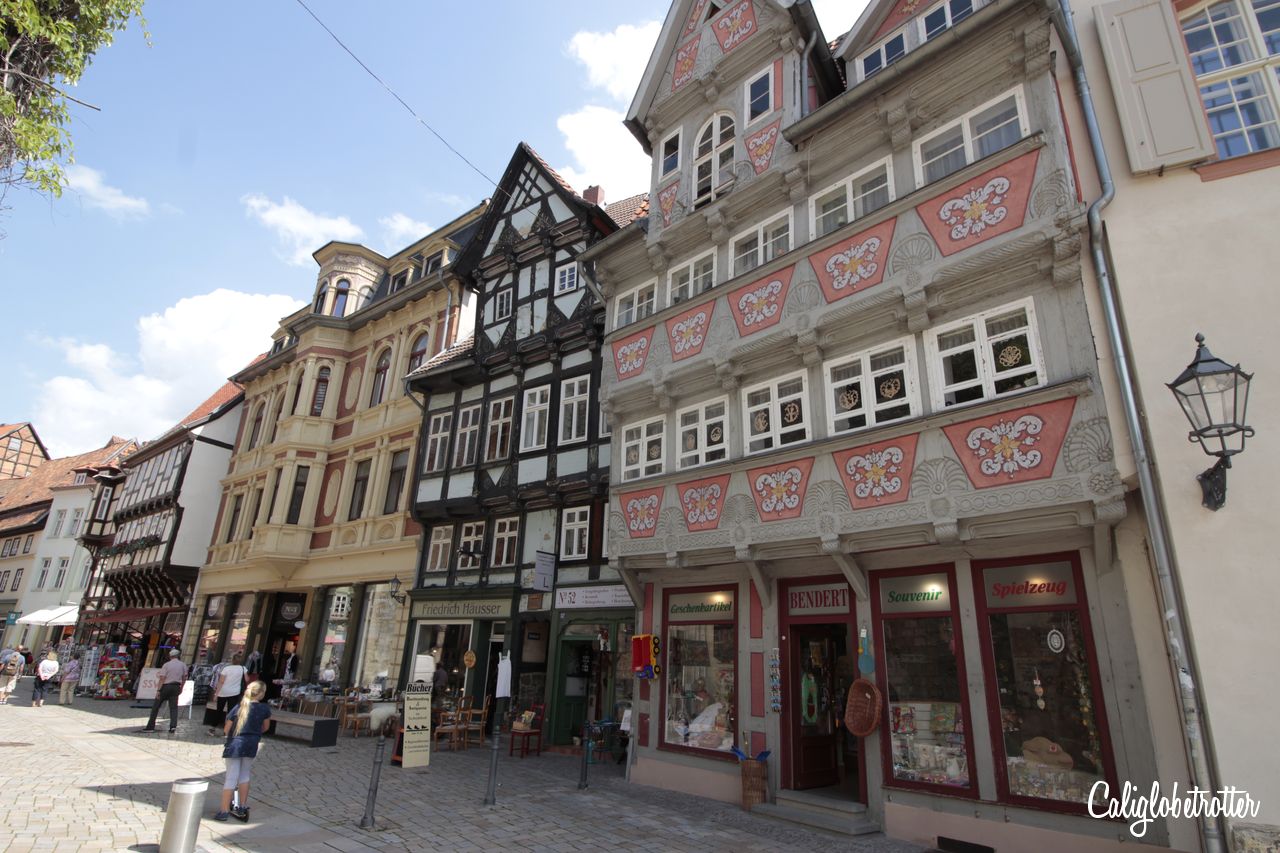
From there we meandered street by street until we came upon St. Nikolaikirche (St. Nicholas Church). Prior to arriving, we stumbled upon a beautiful oddly shaped square with the church peaking out in the distance. Upon closer inspection, we discovered another beautiful row of half-timbered houses which square up the church. It truly felt like one of the most amazing medieval towns in Germany!


Quedlinburg is also home to Germany’s oldest house on Wordgasse 3, which today is the Fachwerkmuseum (half-timbered museum) which explains the construction and techniques used to build the most adorable houses in Europe. The building is rather plain, but dates back to 1310! The museum is closed on Mondays and Tuesdays.
Not far from here is the St. Blasii Kirche from the 10thcentury. Being curious and not wanting to miss out on something great, we meandered inside and were greeted to an interesting style of pews. Wooden pews for standing room only was a welcome variety for once while visiting a church.

As you slowly wind your way down one cobbled-stoned street after another in the direction of the Schlossberg, you’ll come upon the Finkenherdhaus (left), which is a little independent sliver of half-timbered houses. Each picture below shows opposite ends of this row of houses. Supposedly, King Heinrich I was busy catching finches here when he received the news that he would become king.
If you’re looking for where to eat in Quedlinburg, shortly, you’ll come upon a lovely square just below the Schlossberg, with just a few cafes, including the Käsekuchen Cafe which has over 145 different types of German Cheesecakes (not all at once). Right next door is the Alter Klopstock, which is the birthplace of the 18th century poet Friedrich Gottlieb Klopstock, referred to sometimes as the German Homer.
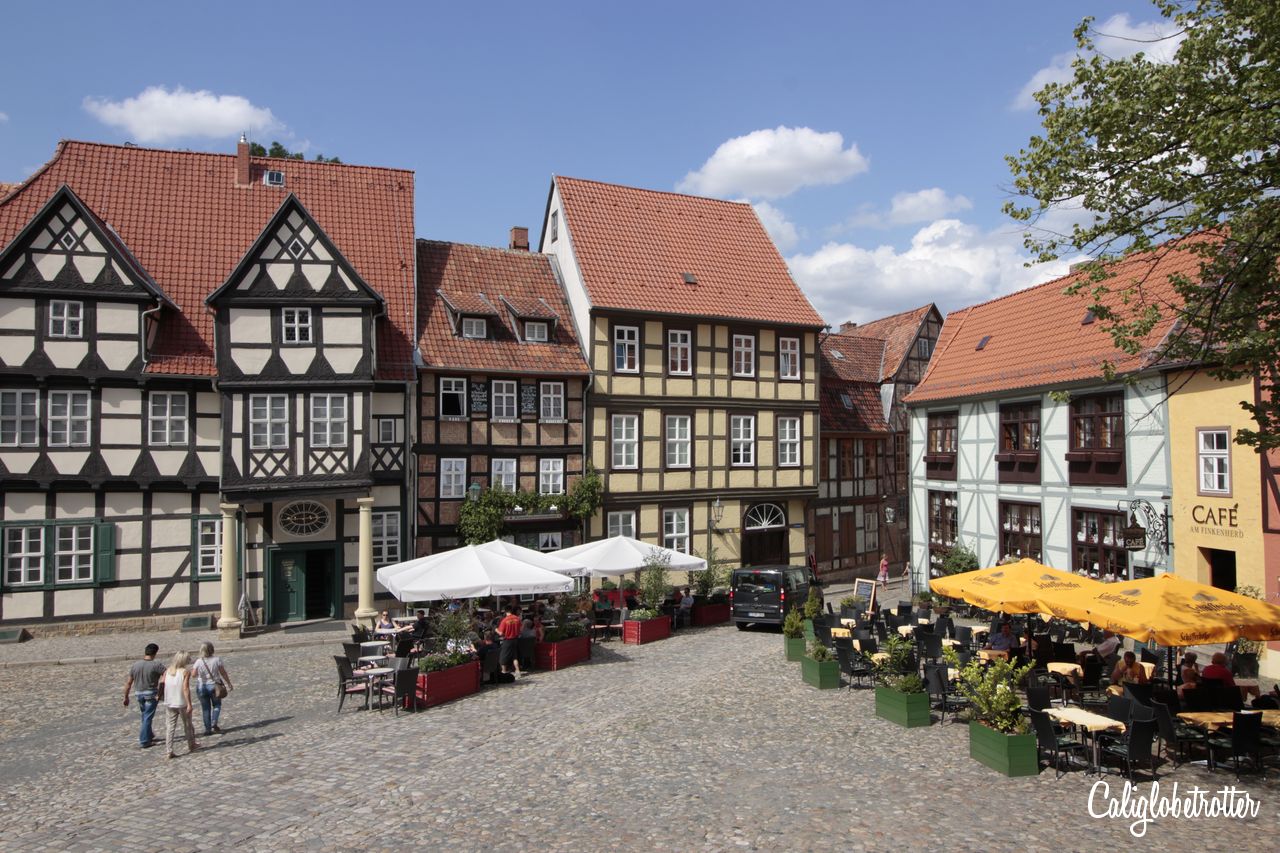
Perched on a 25 meter plateau rising above the town, you will find the Schlossberg, a combination of the Romaneqsue Stiftskirche St. Servatius, a former abbey built between the 10-12th centuries which houses valuable reliquaries in the Schatzkammer (Treasury), as well as the Schlossmuseum (Castle Museum). The church is one of the top things to do in Quedlinburg and should not be missed! Of importance here are the collection of golden chests, religious manuscripts, ivory combs, crystal bottles and swords, dating from the 10th, 11th and 12th centuries, some of which was missing for many years after WWII (more on that below). The museum also has a small but intriguing exhibition on the Nazi propaganda, although everything is only in German.
You cannot visit the inside of the church without combining it with either the treasury or museum or both. Quite personally, we didn’t feel that it was worth the price and were quite frustrated that we spent the money. No English translations, hardly anything inside and nothing particularly spectacular. However, the view from the Schlossberg over the town is still amazing, and therefore, well worth the little trek up.
The interesting story about the Quedlinburg treasure is that a young American lieutenant and his unit were supposed to be guarding the treasure in a mine shaft outside of the town for safekeeping during the Second World War. Only, it “disappeared”. Turns out, the Lieutenant had shipped the historic artifacts to his parents’ house in Whiteright, Texas and was quite forgotten about until his death in 1980. His family discovered the priceless artifacts and started to sell off parts of it. In 1989, a jewel-encrusted manuscript showed up at an antique dealer’s in Switzerland. Over time, an investigation was started and led to a bank vault in Whiteright, Texas and was eventually returned to the city in 1992. Two pieces of the treasure have yet to be found.
If you have more time, wander over to Münzenberg just opposite the Schlossberg, to visit the Münzenberg Museum which housed the Marienkloster ( Convent of St. Mary). They say that the view from here over the town and the Schlossberg is stunning. Sadly, we decided not to trek over as we were playing cat and mouse with the weather and the next day’s weather was to be terrible and we wanted to enjoy some of Wernigerode before the storm hit!
Beyond sightseeing sites, the town is best explored wandering from one alley to the next, admiring one colorful half-timbered house after another. By doing so, you can explore the different half-timbered construction styles and find Instagram worthy spots. I was quite in heaven! I would definitely say that Quedlinburg is one of the best towns to visit in Northern Germany as well as one of the prettiest towns in all of Germany!
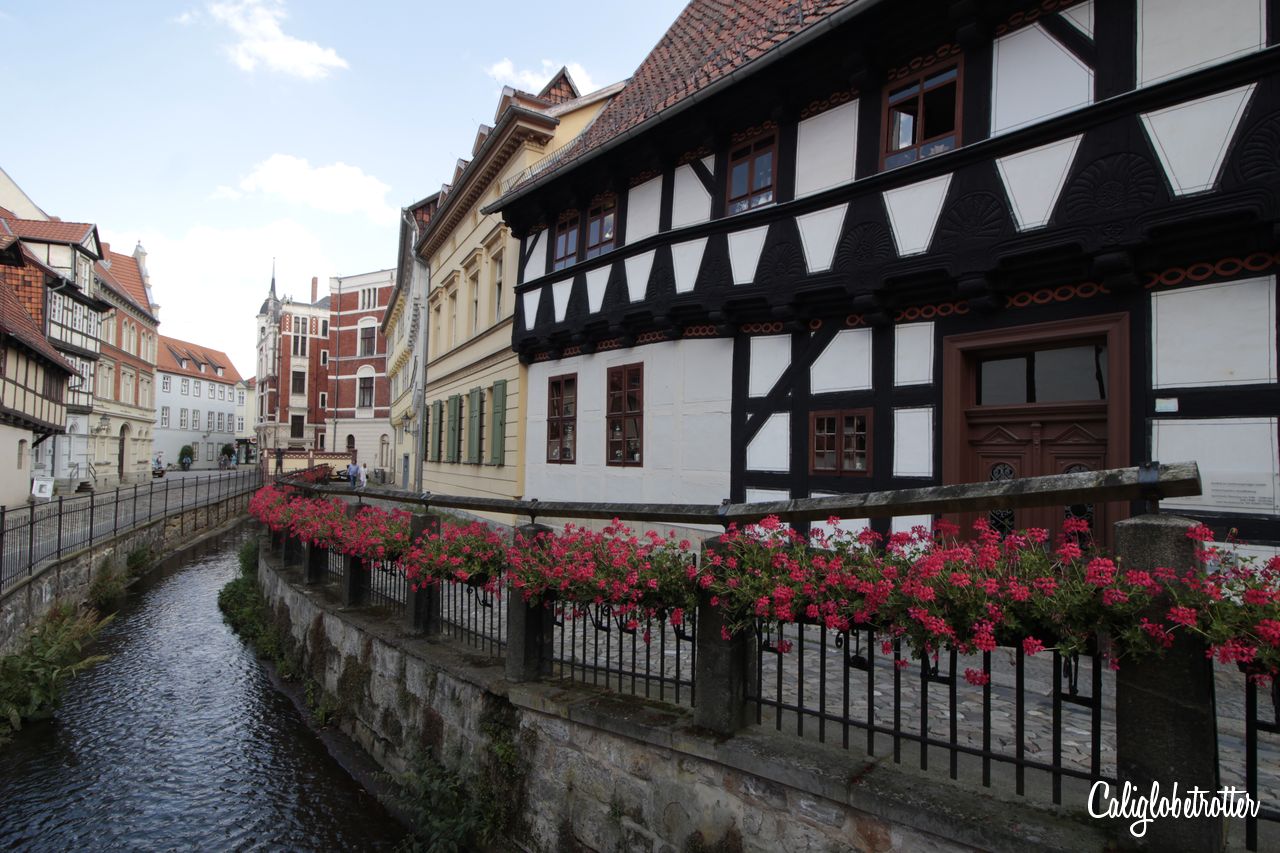

Where to Eat in Quedlinburg
Right off the bat, we sought out a place to eat as we were starving and I had discovered two sources telling me that I HAD to go to Brauhaus, and for good reason. This brewery, located on Blasiistr. 14, is a barn-sized microbrewery with a range of their own seasonal beers to wash down very traditional meals. Couldn’t have picked a better restaurant! Plus, what makes this brewery special is the fact that it’s the LAST of over 200 breweries which were once in Quedlinburg! Their home-brewed beers are famous all over the Harz region! If you’re looking for the best place to eat in Quedlinburg, this is it!

As we were trying to outrun the rain and take advantage of any sunshine, we opted to sit outside in the beer garden, bustling with a large tourist group. This region is quite renowned for dark beer, for which I had no idea, but quickly fell in love with it. I enjoyed the Lüdde Schwarzbier while my husband enjoyed Lüdde Braunbier, which was a sweeter version, sort of like a Dunkles Radler.
I enjoyed, quite possibly the best meal ever, the #46 Bierfleisch (slices of pork in a creamy dark beer sauce with Rotkohl and Knödle). Highly recommended!
How to Get to Quedlinburg
Undoubtedly, one of the main reasons small towns like Quedlinburg have remained relatively undiscovered and retained their authenticity is because of the fact that towns like these aren’t always easy to get to. Sure, you can arrive by train by getting off at the Quedlinburg Bahnhof, but going by train could take much longer.
It’s therefore, much easier to arrive by car. Coming from larger cities like Hamburg and Berlin would make for an easy day trip. The town has several parking lots on the outskirts of the historic center, just a five minute walk.
Where to Stay in Quedlinburg:

⭐⭐⭐⭐ Hotel Theophano – located in the heart of the historic town, this half-timbered hotel is family-owned and offers a sauna! With higher prices than other hotels, it’s still VERY affordable for the region!
⭐⭐⭐ Hotel zur goldenen Sonne – located just a few minutes walk from the Markt and within easy walking distance of the St. Nikolaikirche offers cozy and simple rooms at an affordable price.
⭐⭐⭐ Hotel Balneolum Superior – a hotel where the locals go for some R&R to enjoy a healthy Harz holiday loaded with massages, spas and jacuzzis, a popular past time in this region.
With any booking of a hotel in the town, you’ll be entitled to a small coupon book (Gästekarte) good for surrounding activities, restaurants and shops! Be sure to pick it up from your hotel at check-in!
You can also purchase the HarzCard for 29€ which includes entry to over a hundred regional attractions for 48 hours. You can also up it to 59 € for 4 days.
A Ride on the Steam Train to the Brocken

The Harz region is a winding network of gauge steam trains that connect the towns together. Visitors are encouraged to take the time to hop aboard these historic trains for a ride to the Brocken, a “mini-Black Forest” to the northern Germans. The Brocken is the highest point in the region, which lies at the heart of the Harz National Park, filled with captivating pagan stories of local witches gathering on Walpurgisnacht (April 30th) at Hexentanzplatz in Thale.
As legend would have it, every year, witches and warlocks descend on the Harz to fly up to the Brocken on their broomsticks and goats. They exchange tall tales of evil deeds and hang out with the devil himself who maligns God, his angles and his teachings. For centuries, the surrounding locals lived in fear of running into a witch and to protect themselves, they hung crosses and herbs on their houses. The most superstitious would crack whips to ward off any evil forces.
Other less spooky tales include witches driving out the winter and greeting the spring by dancing around a fire.

The train ride (from Wernigerode) takes about 2 hours to arrive at the Brocken. You can also catch the train from Quedlinburg. The trains have been running since 1898 but for a short period, after some destruction caused during WWII and the division of Germany, the lines were discontinued until after the reunification of Germany in 1990. (For more information on the Steam Trains)
You can request seat reservations by booking online. You will email with a woman who will reserve your tickets. She will ask if you want the normal train or the special train. Not knowing there wasn’t much of a difference between either train, we opted for the special train, forking out 44 € each for a round trip ticket. However, our ticket included free entry into the Brocken Haus Museum to learn about the history of the region and how the Brocken was used by the DDR to spy on Western Germany.
Once on the train, you can walk around from one wagon to the next, taking pictures of the stream train as it winds its way up the mountain. Try not to be outside when going through any tunnels as the smoke from the engine with engulf you and is terrible to breathe!
If you’re interested in visiting Germany and are looking for more information, I highly recommend using the DK Eyewitness Travel Guide! Without these guides, I would be lost! This is my travel Bible!
 |  |  |  |
Disclaimer: This post contains affiliate links. If you click on one and make a purchase, I might make a little extra spending money, at no extra cost to you. As always, all opinions are my own and these products/services have been found useful during our travels and come highly recommended to you from yours truly!
Stay Tuned for Other Posts from the Harz:
Wernigerode: The Heart of the Harz
Goslar: A Quintessential Half-timbered Town
The Most Idyllic Steam Trains in the Harz Mountains
Liked this post? PIN IT FOR LATER!!
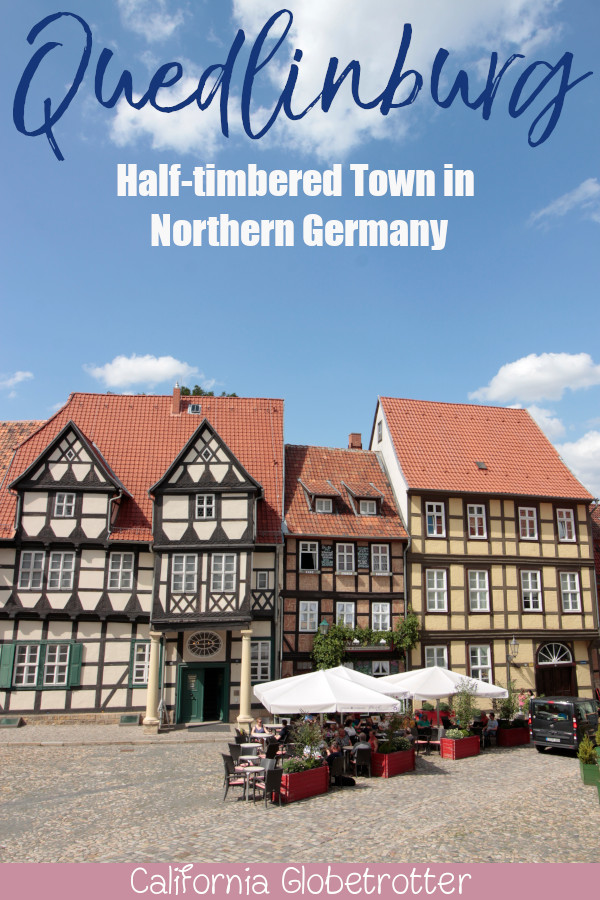
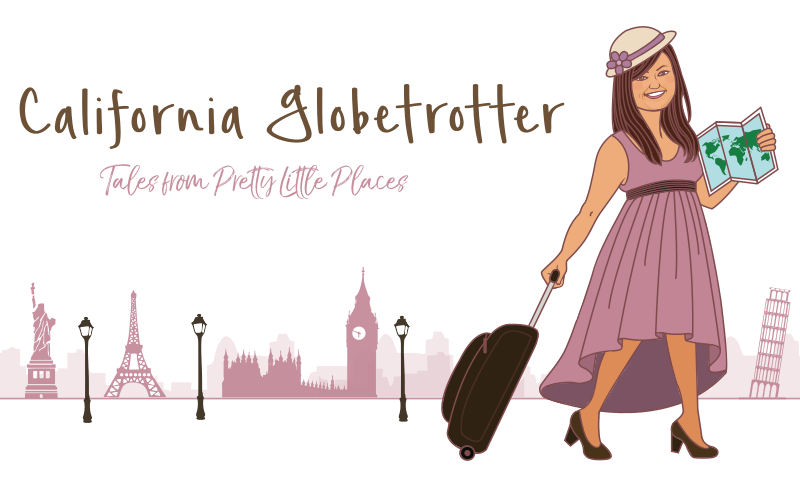









Thanks Lorelei really informative post.
We love travelling around Germany and I will definitely be adding this to our list, we have mostly toured around east and southern Germany, but the Harz region looks fantastic as well. I look forward to reading more of your posts from this region.
Happy Travels
Oh great! Ya stay tuned for more adorable posts from this region!
This is one of the reasons I love Germany so much! 😀 from the north to the south there is something to see! 😀
I’d never heard of this one, but looks like it might give Rothenburg a run for its money. Will definitely check it out. And great pics!
Allllll of the half-timbered towns I’ve visited would DEFINITELY give Rothenburg a run for its money! There is so much more to Germanys small towns that Rothenburg and it’s a crying shame so many only go there!
The food looks absolutely heavenly! Next time I go to Germany I will definitely try that place out!
What a charming town!! It must have felt like going back in time. Love how beautifully preserved the buildings are, and would be fascinated to know more about the Nazi aspect of its history! Feel like too many people these days have forgotten about the evils of Nazism 🙁
Sadly I agree! Feels like history is going to repeat itself!
Hi Michelle,
Quedlinburg was no real centre of nazism like Nürnberg. Himmler tryed to use St. Servatius as a symbol. Cause Quedlinburg was a favourite of King Heinrich and many following Kings of the so called “Heiliges römisches Reich deutscher Nationen” (“Holy Roman Empire of the German Nation”) which lasted nearly 1000 years. So the place as a favourite place to stay of former Kings and the religios metaphor of a 1000 years lasting empire fitted the Nazi propaganda! And an very very interesting fact is, actually not everything connected to the nazis cauld be rolled back. So, St. Servatius was changed. A heavy Svadrika was hung up in the presbytery. For that, the presbytery was changed: there were build several additional stonewalls to hold the Svadrika. As you may noticed, the church lays on a sandstone mountain which is slithering and moving on its several layers of sandstone. That is a huge problem today and the fact, why not all sandstone walls, built up under the nazis could be broken down afterwards. They are important for the stability of the church today.
When you are visiting Germany, or Europe in general, You will have the opportunity to visit several memorials and museums of former KZ (concentration camps). We are not hiding our history! But please, don’t call every german a nazi.
Regards Tino
I don’t think she was implying that Germans are hiding their history or that Germans have forgotten about the horrors of Nazism, but rather with what’s currently happening in the US at the moment. 🙁
Hi,
Waited long enough for your post about Quedlinburg, so thanks for your awesome post. I’m happy you spotted on some funny or even interesting details mentioned on instagram. 🙂
I don’t know if you are still in the Harz region, if not, you HAVE to return and give “Stolberg” a try. Don’t want to spoiler too much 🙂 only: it’s worth a day-trip!
Greetings from Quedlinburg
Tino
Hi Tino! Thanks for patiently waiting for my post! We really enjoyed Quedlinburg and I hope I did it justice! We’re not in the Harz region anymore but Stolberg has also been on my list as well as a few more towns in that region, so I’ll definitely be back! Stay tuned for Goslar and Wernigerode!
Trust you to find another amazing half timbered German town! This one is once again, a stunner. Especially with the water running through it, gives it an extra touch (hey, we Dutchies love a canal or two).
#WanderfulWednesday
Oh I have enough half-timbered towns to last a life time haha
Wow Lorelei, these old medieval towns are truly remarkable. They remind me of fairy tale stories. I love your photos and I can’t believe that Church was from the 10th Century. #WanderfulWednesday
Lorelle
https://amindfultravellerblog.wordpress.com/
another cute town:) #wanderfulwednesday
You’re totally right that Quedlinburg looks like a fairytale with all of those half timbered houses, and I also can’t believe how old it is! That’s so sad that that American soldier had some of the treasure shipped back home, and that still some of the pieces haven’t been found yet.
I’m sure over time they too will be found and returned!
Germany is so charming and full of history! I love following along your half-timbered journey! I could do without those withes though lol!
AHHH!!! So many of my favorite IG pictures in larger sizes!! This town looks magical. I feel like I want to do a winter road trip (and a spring one, too) through all these half-timbered towns!
Oh I’m sure winter would be lovely when they’re covered in snow!…if they get any up there, I have no idea
Like you mentioned, who wouldn’t want to visit this town? Love how you are exposing readers to these parts of Germany that do not get a lot of publicity (not sure if that is the correct way to describe them). Was surprised to see the wooden pews. Saw a similar things in Philadelphia (in there, rich people paid to be seated during mass). #wanderfulwednesday
That’s why I love writing about these smaller half-timbered towns, to expose them to people who would otherwise only go to Rothenburg ob der Tauber when there are a hundred more than are equally beautiful!
Another beautiful find Lori – I would love to visit Quedlinburg one day and wander its fairytale streets. I appreciate you present these places warts and all too. It is important we learn from the past and our current mistakes. You are ALWAYS welcome on #FarawayFiles
Thank you Katy! So glad I could introduce you warts and all! ?
Loved the fascinating and quirky history of Quedlinburg. Do you think the special train was worth the extra dough? I could definitely get behind quaffing a local brew at the Brahaus too! Thanks for sharing this quaint place with #FarawayFiles!
Ya the train ride was cool, but I expected it to be a bit more fancy than wooden benches. The scenery wasn’t sooooo exciting but it was beautiful. A post about that is also coming soon!
Wow! You’ve really outdone yourself this time! The photos of this place are amazing! I love the one with the flowers on the river! #farawayfiles
Thanks! This is only the beginning! 🙂
Another beautiful medieval German town! They just never run out of it don’t they? The history is very interesting, I’d say it’s the origin of girl power. :p Sad though that it became a center of the Nazi propaganda, on the brighter side (not that you can see anything “bright” during that time) – it’s also probably the reason why it suffered very less damage during the war and is now a very well-preserved medieval town.
That Quedlinburg treasure guard is a hoot! :p
That is a good point as to why it could have been spared!
WOW! You just put another place onto my travel bucket list! This is medieval heaven! THANKS! #FarawayFiles
Cha-ching!haha
Top tip about the voucher book, this looks idyllic
Another lovely German half-timbered town I have never heard about! Thank you for this informative post. I think it is high time for me to start planning a trip to Germany. 🙂
I think you’re right!
It really does look like something out of Disney, so the steam train fits right in. That pork dish looks really interesting too, would love to try it. #TheWeeklyPostcard.
Oo, I wonder where those 2 bits of treasure are today!? That’s really interesting stuff about Himler and the propogander – I love facts like that. The town itself looks fab too, how amzing it wasn’t scathed in the war! #farawayflies
I love the Harz!! I’ve only been to the Lower Saxony part of it but definitely want to come back and explore more of the region – it’s just so stunning!!
What a charming town! We had never heard of Quedlinburg, but now it’s firmly on our Germany wish list. The history is as impressive as the half-timbered lanes. It’s interesting how events that seem unfortunate end up preserving pieces of history. Not sure when we’ll get there, but I have the feeling we’re going to love the whole Harz region! Thanks for putting it on our radar!
Oh you’ll love it! Stay tuned for more towns!!
Loved seeing all your pictures of Quedlinburg on Instagram so it was so much fun to finally see this post! It looks like an absolutely beautiful little town, I’m glad it survived!
OMG this is the cutest little town!! We haven’t been to Germany in 15 years…I think it’s about time for a return trip! Pinning for later!
Be sure to check out my newest post on Wernigerode is you loved this town!
What a pretty town. Looks like a lovely spot to spend a day wondering about.
Wow, Quedlinburg is just packed with history! The oldest house, the first medieval capital and an 800 year span of female rule, how have I never heard of here before?! The fact that it is yet another awesome half-timbered town hasn’t escaped my notice haha. That steam train looks awfully cute too. I need to go to Germany clearly. #theWeeklyPostcard
Clearly! ? Still waiting! Haha
Great Article! My dad grew up in a town just west of there (in West Germany after the war). We spent many summers in the Hartz Mts. as kids. I have very fond memories of the area, your article was like a trip back to my childhood.
Oh so glad I could bring back joyful memories for you!!
Another adorable town! I think my favorite part of this is where King Heinrich I was catching finches when he received word he was to become king. What a charming part of history! And I’m going to have to check into that train also. Thanks for the e-tour!